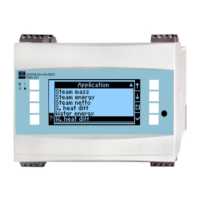Appendix RMS621
68 Endress+Hauser
11.2.1 Flow calculation based on the differential pressure method
RMx621 has 2 ways of measuring differential pressure:
• Traditional differential pressure method
• Improved differential pressure method
Traditional differential pressure method:
All the coefficients of the flow calculation equation are calculated once in the design parameter and
are combined to form a constant.
Improved differential pressure method:
In contrast to the traditional method, the coefficients of the flow equation (flow coefficient,
preacceleration factor, expansion number, density, etc.) are constantly recomputed as per ISO
5167. This has the advantage that the flow is determined exactly even under fluctuating process
conditions, far beyond the design parameter (temperature and pressure in sizing parameter), thereby
ensuring greater accuracy in flow measurement.
For this, the device just needs the following data:
• Internal diameter
• Diameter ratio ß (K-factor for Pitot tubes)
ƒ = correction factor (correction of measurement, e.g. to take pipe roughness into account)
Temperature effect on internal diameter and diameter ratio β
Please note: the pipe data often refer to the manufacturing temperature (approx. 20 C) or process
temperature. The data are automatically converted to the operating temperature. For this purpose,
just the expansion coefficient of the pipe material has to be entered.
(Differential pressure1 Æ Correction: yes Æ Expansion coefficient: ...)
Temperature compensation can be omitted in the event of minor deviation (± 50 C) from the
calibration temperature.
Pitot tubes
When using Pitot tubes, a correction factor has to be entered instead of the diameter ratio. This
factor (resistance coefficient) is specified by the probe manufacturer, and in the form of the K-factor
by E+H for "Deltatop".
It is absolutely imperative that this correction factor be entered! (See following example).
Traditional differential pressure method Improved differential pressure method
Only accurate in design parameter (pressure, temperature,
flow)
Accurate in every operating point thanks to fully
compensated flow calculation
Signal of the DP transmitter is square root, i.e. scaled to the
operating volume or mass
Curve of the DP transmitter signal is linear, i.e. scaled to the
differential pressure
ρ
π
ε
β
⋅∆⋅⋅⋅⋅
−
⋅= pd
c
Qm 2
4
²
1
1
4
⋅
=Qm
∆⋅ p2
k
⋅

